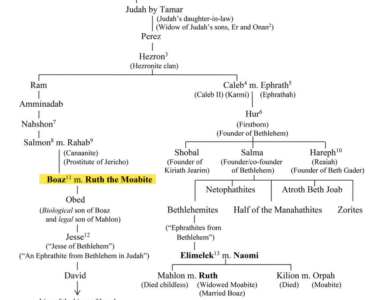 For centuries, visual imagery has been used to communicate the textual stories and teachings of the Bible. Hand-painted illumination, illustrations, fine art have all helped make Scripture more quickly accessible to the common person. In today’s world, infographics are one more way to share that message.
For centuries, visual imagery has been used to communicate the textual stories and teachings of the Bible. Hand-painted illumination, illustrations, fine art have all helped make Scripture more quickly accessible to the common person. In today’s world, infographics are one more way to share that message.
Bible Gateway interviewed Karen Sawrey (@karensawrey) about The Infographic Bible: Visualising the Drama of God’s Word (Zondervan, 2018).
What is an infographic?
Karen Sawrey: The Collins English Dictionary has a great explanation already prepared for me: “A graph, diagram, or other visual image designed to present complex information in an easily understandable form.”
What is The Infographic Bible and who is it for?
Karen Sawrey: I’ve had the honor of spending the last five years working on The Infographic Bible, by far the hardest piece of work I’ve completed in my career, but, of course, the most incredible! My hope is that it’s a blessing to many, as it’s been written with a millennial audience in mind. A global visual language is quickly becoming the currency of communication for this generation and research has shown that combining visuals with text astronomically improves communication and learning.
Jesus spoke in parables, creating images to help his audience to understand and remember the essence of his message and Paul chose to write in the street language of the day. The Infographic Bible’s aim is to do both: to create a visual image and support it with text that can be understood by anyone that picks up the book.
The Infographic Bible does not simply illustrate the biblical text. It does not cover every book, nor is it a replacement for the Bible. Its intent is always to point back to Scripture. It is an invitation for the audience to interact with God’s life-giving Word in a fun and relevant way, no matter where they are in their journey with God.
It’s meant to be enjoyed!
Why have you chosen the theme of restored relationship to tell the Bible’s big picture?
Karen Sawrey: Many themes could be used when describing the ‘big picture’ of the Bible. I chose to use the theme of God’s love and his commitment to a relationship with us for several reasons, not least because it mirrors my own journey and experience of God. Psalm 103:2-5 pretty much sums it up: “Praise the Lord, my soul, and forget not all his benefits—who forgives all your sins and heals all your diseases, who redeems your life from the pit and crowns you with love and compassion, who satisfies your desires with good things so that your youth is renewed like the eagle’s.” His heart for a relationship with us continues to astound me daily; it just oozes love, grace, and mercy!
We were created for relationship with God and also with each other. One of the greatest privileges of being the author of this work meant that I could purposefully gather a wide range of contributors from a variety of different theological backgrounds. I believe those differences are not something to be feared, but to be embraced and grappled with relationally. A healthy maturity and unity come from this kind of wrestling.
I’m such an evangelist at heart, making me so excited about the Bible’s big picture that in the preliminary pages of the book I invite the audience to take a sneak peek at p. 206. I’d love it if the first thing my audience sees when they open The Infographic Bible is the gospel message.
There’s no greater hope than the restoration of all things, which Revelation 21 lays out for us beautifully, and that hope is so important to keep our sights fixed on (see page 204).
Why was writing the graphic label text one of your greatest challenges with this project?
Karen Sawrey: Think about fitting a camel through the eye of a needle. That’s what I felt like I was doing!
Small text is standard in the world of infographic books but in the case of The Infographic Bible, we were attempting to squeeze these biblical scholars’ minds and thoughts into concise, pithy sentences. This, of course, was a long, detailed process with experts in the field and creating the data was by far the most time-consuming exercise. The text’s role is to support and further explain the graphic, with the least possible amount of words.
I was in earnest when I said I wanted to supply a magnifying glass along with the book!
Select three infographics from the book and explain them.
Karen Sawrey: The infographic: All Prophecies about Jesus (pages 128-129).
This graphic is full of life and hope; it’s one of the most powerful in the whole book because it reveals Jesus as the Messiah! It shows every messianic Old Testament prophecy and then how those were fulfilled in the New Testament. It’s the very thing that the Christian faith is based upon… and that’s what makes it so very exciting! In essence, these infographics solidify and reveal the truth of Mathew 5:17 (“Do not think that I have come to abolish the Law or the Prophets; I have not come to abolish them but to fulfill them”).
What information is shown:
This was one of my most complex data sets. It’s so rich and nuanced that this infographic really is a big picture. I wanted the audience to grasp the sheer volume of those prophecies fulfilled. That was the main aim here; they were not expected to follow each line from prophecy to fulfillment.
There are some deeper levels of information that the reader can explore should they wish to, but not doing so won’t detract from the main messages of the infographic.
The first level being where in the Bible those prophecies and fulfillments are, and then the quantity each book holds. This is shown by the circles laid out on the X-axis of the chart, placed in canon order from left to right.
The second is how the prophecy was fulfilled, which is revealed by the type of line: dashed for affirmation by others, dotted for a claim of Jesus, and solid for a record of an event.
Then thirdly, what was the theme of the prophecy, and this is shown by the line color. The chart reveals, for example, that Isaiah contains lots of prophecies on the themes of ‘How He Will Redeem’ and ‘How It Will End’ toward the second half of the book.
Purposeful design elements:
This infographic is the bridging of the Old and New Testaments. It spans where the paper changes from the Old Testament’s uncoated, to the New Testament’s coated paper. I know it sounds geeky but it’s been strategically placed so the reader can experience the shift between testaments and between prophecy and fulfillment. Even if it was your first encounter with the Bible, your fingers would feel the change.
The design also has meaning. The circles marking each prophecy are only outlined, and the circles for fulfillments are solid to reflect each prophecy has been completed. Colors are chosen to communicate Jesus’ presence, using the tones of spring and summer.
I wanted the circle endpoints all laid on the X-axis rather than sitting adjacent to each other on the Y-axis, so that the connecting lines create a rainbow… indicating the hope that Jesus brings!
———————————
The infographic: Jesus’ Prophecies in the Gospels (pages 126–127).
This is a zoomed-in prelude to ‘All the Prophecies about Jesus,’ using the same data set and key, and, of course, all the same design elements.
What information is shown:
Zooming in only on the prophecies fulfilled in the Gospels, I was able to show some more exciting details from this data set and placing it on the page in a new way reveals fresh patterns and totals. The first thing now seen is what the individual Bible verses are, along with a summary for both the prophecy and the gospel fulfillment.
The placement of the dots has also changed. To the left, the prophecies have been grouped first by theme and then canon order; this clearly shows the quantity of prophecies for each theme. To the right of the page the fulfillments have been grouped by type, and then canon order so again the reader can clearly see the quantity of each.
The audience can, if they choose, follow some of the lines from prophecy to fulfillment; however, as it’s a bound book, that’s not the main purpose of the infographic. It was designed to show there are connections and the beautiful pattern those connections weave.
———————————
The infographic: The Nature and Character of God (pages 26-27).
Essentially, we’re trying to describe the indescribable. So… no pressure.
What information is shown:
Many books on systematic theology use the method of dividing God into two parts: God’s transcendent nature and God’s character. This chart type is used to visualize part-to-whole data; it works well here to show the categories and sub-categories of those parts used in the Bible to describe God.
In addition to the two parts of who God is, he’s wholly love whilst being holy and perfect at his core.
Purposeful design elements:
The top half, purposefully placed to represent God’s heavenly nature, shows those things that God is, and we are not. And so God’s character is placed at the bottom—this shows his attributes that we can develop on earth.
Blue is chosen to represent heaven, the green for creation and restoring, gold for divinity, and pink for love. Specifically, the pink used has become known amongst my team and I as ‘God is love’ pink: it’s a mix of the colors I’ve used to represent the Trinity: burgundy for the Father, pink for Jesus, and gold for the Holy Spirit.
How should people read The Infographic Bible?
Karen Sawrey: I would suggest with a cup of tea; after all, it’s meant to be enjoyed!
But some of the graphics will take time, and so it’s not a quick read; rather, it’s a coffee-table book to be enjoyed and processed slowly.
The contents page is a good place to help navigate your way through the book and serves as a visual to show what stage in the big-picture narrative each subject falls.
The infographics range from simple to complex, showing different levels of information. Look out for a key on the more complex ones to help you process that information. Remember that the graphics take the leading role with the text playing only a supportive one.
Essentially there’s no right way to read it. You may choose to read cover-to-cover because it does follow the Bible’s big picture from Genesis to Revelation. However, all of the graphics can be read in isolation, and if you do, keep an eye out for the colored tab at the bottom left of the spread; it’ll show you where in the big picture that graphic sits, along with giving you a handy link to where other pages may relate to that subject.
Just remember, freedom reigns!
What is a favorite Bible passage of yours and why?
Karen Sawrey: It’s such a tough choice. Please can I have two? John 10:10, where Jesus declares he’s come that we may have life and life to the full, and Luke 1:37 (NKJV), that says with God nothing is impossible.
With God, we get to do those things the world says are impossible. Of course it takes risk and vulnerability from us, and creating this book has taken both!
What are your thoughts about Bible Gateway and the Bible Gateway App and Bible Audio App?
Karen Sawrey: Wow, I’m so thankful for everyone involved in creating Bible Gateway. It’s such an incredible tool; one which I regularly use and love. I especially appreciate the ability to compare different translations at the same time.
Is there anything else you’d like to say?
Karen Sawrey: I believe the Bible is one of the key places we encounter God and his heart for a relationship with us, bringing nourishment and wholeness (Proverbs 4:20-22). It’s an incredible, life-bringing gift extended to every single person—enjoy!
The Infographic Bible (website) (@theinfobible) is published by HarperCollins Christian Publishing, Inc., the parent company of Bible Gateway.
Bio: Conceptual designer, illustrator, and lover of all things paper and ink, Karen Sawrey is passionate about engaging a visual generation with creative ways to see and digest information. Karen has over 20 years experience stretching across a wide range of media, including top magazines, global charities, and publishers, including HarperCollins, Hodder & Stoughton, and Penguin Random House. Having worked in central London, she now continues to flourish as a creative among the Northern Hills, still loving paper, people, and life to the full.
Get premium Bible reference resources without paying for expensive software when you become a member of Bible Gateway Plus. Try it right now!
The post The Bible Explained with Infographics: An Interview with Karen Sawrey appeared first on Bible Gateway Blog.












